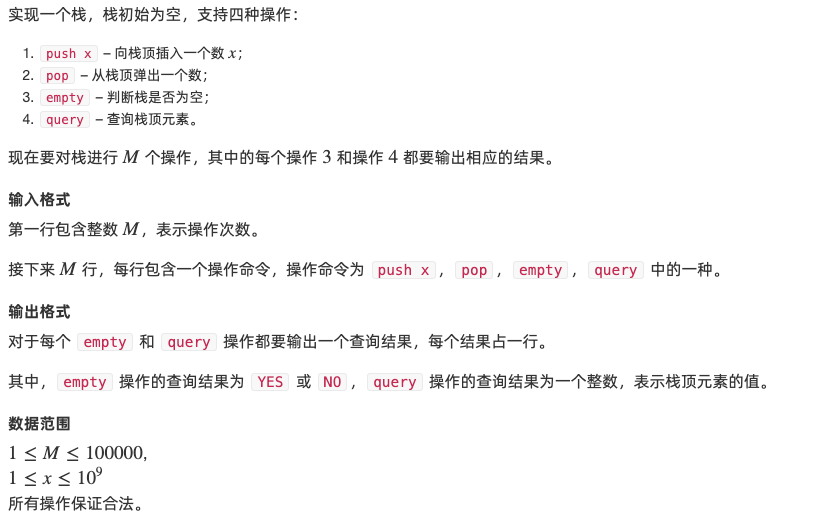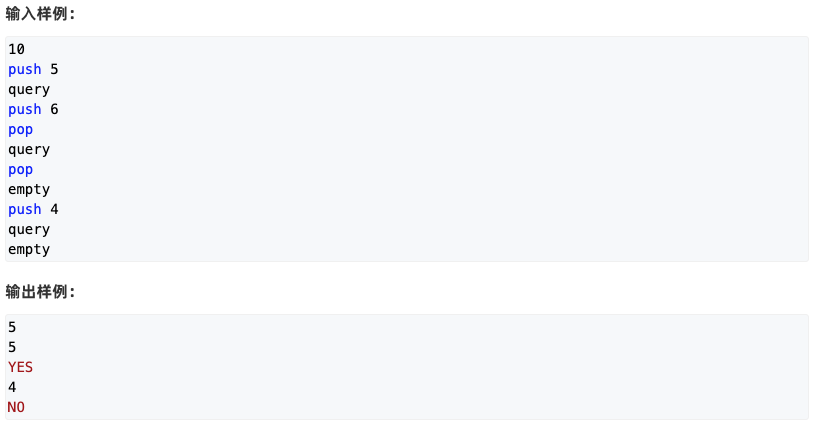学习顺序:
- 学会使用STL的基本用法
- 学会使用STL解决问题
- 学会用一维数组模拟栈,解决问题
stack stk
stack<int> s;s.push(3);s.push(2);s.push(5);cout << s.top(); // 5s.pop();cout << s.top(); // 2
一维数组模拟栈
https://www.acwing.com/problem/content/830/

// tt指针初始化为0,第一个数存在1上,当tt==0的时候,代表空栈#include <iostream>using namespace std;const int N = 1e5 + 10;int stk[N];int tt = 0;int main(){int M;cin >> M;string op;int x;while (M--){cin >> op;if (op == "push"){cin >> x;stk[++tt] = x;}if (op == "pop"){tt--;}if (op == "empty"){if (tt == 0) cout << "YES" << endl;else cout << "NO" << endl;}if (op == "query"){cout << stk[tt] << endl;}}return 0;}
例题,【例1-2】后缀表达式的值
//用一个栈维护数字,用一个栈维护运算符//这道题目没有括号,另外注意运算数的数值范围比较大//不开LL见祖宗
例题,表达式括号匹配(stack)
//用一个栈维护左括号和右括号的关系//右括号,没有左括号配对就是非法//左括号,最后没有右括号配对就是非法
例题,车厢调度(train)
//第一种方法,把一系列车厢,当成一个数组,1, 2, 3, 4, ..., n//x读进来了,那么,我们就要认为:x之后的数字,都不应该出现在栈中;x之前的数字没入栈的都应该入栈//标记在不在栈里的方法,1代表在栈里面,2代表已经出栈//第二种方法,用一个stack硬来模拟这个进出栈的过程(冷不丁让我重写,我想我是模拟不出来的)//如果stack空的,把前面没入栈的入栈//如果stack非空,栈顶元素如果比我大,那是非法的;//整个过程中,用一个变量tp,初始值设为1,来维护栈顶元素的值
例题,中缀表达式值(expr)
//在这道题目上,我一共花费了4个小时//所以,我建议你自己做,研究至少花费2个小时。//可以很好的提升代码能力,加深对栈的理解,对表达式的理解//第一种方法,直接利用中缀表达式,进行求解,这个方法和前面的题目类似//第二种方法,中缀读进来,然后转成后缀//后缀的建立,用一个queue<node>进行维护,node可以是运算数,也可以是运算符//node需要使用struct定义一下//关于非法情况的判断//首先这道题目的数据,没有那么严格,不需要判断除数不能为0的情况//其他非法,左右括号不匹配问题;只有一位,这一位还是运算符; 上来第一位是+*/运算符,负号是可以的//中缀表达式,两个运算符连在一块了;右括号没有左括号匹配,左括号没有右括号匹配//网上能搜到题解,对左括号个数和右括号个数相同作为配对的原则,这个其实不严谨//运算符优先级,可以写一个函数实现,也可以写一个map预设好
例题,P1981 [NOIP2013 普及组] 表达式求值
#include <iostream>#include <cstring>#include <algorithm>#include <stack>#include <unordered_map>using namespace std;const int MOD = 10000;stack<int> num;stack<char> op;void eval(){int b = num.top(); num.pop();int a = num.top(); num.pop();char c = op.top(); op.pop();if (c == '+') num.push((a + b) % MOD);else num.push(a * b % MOD);}int main(){string s;cin >> s;unordered_map<char, int> pr{{'+', 1}, {'*', 2}};for (int i = 0; i < s.size(); i ++ ){if (isdigit(s[i])){int j = i, x = 0;while (j < s.size() && isdigit(s[j])) x = x * 10 + s[j ++ ] - '0';num.push(x % MOD);i = j - 1;}else{while (op.size() && pr[op.top()] >= pr[s[i]]) eval();op.push(s[i]);}}while (op.size()) eval();cout << num.top() << endl;return 0;}// 以后的习题中,会涉及一个表示式树的题目

